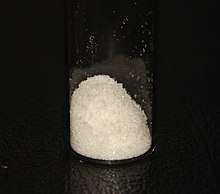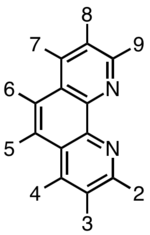Phenanthroline
Phenanthroline (phen) is a heterocyclic organic compound. It is a white solid that is soluble in organic solvents. It is used as a ligand in coordination chemistry, forming strong complexes with most metal ions.[3][4] It is often sold as the monohydrate.
 | |
 | |
| Names | |
|---|---|
| Preferred IUPAC name
1,10-Phenanthroline[1] | |
| Identifiers | |
CAS Number |
|
3D model (JSmol) |
|
Beilstein Reference |
126461 |
| ChEBI | |
| ChEMBL |
|
| ChemSpider | |
| DrugBank | |
| ECHA InfoCard | 100.000.572 |
| EC Number |
|
Gmelin Reference |
4040 |
| KEGG | |
PubChem CID |
|
| RTECS number |
|
| UNII |
|
| UN number | 2811 |
CompTox Dashboard (EPA) |
|
InChI
| |
SMILES
| |
| Properties | |
Chemical formula |
C12H8N2 |
| Molar mass | 180.21 g/mol |
| Appearance | colourless crystals |
| Density | 1.31 g/cm3 |
| Melting point | 117 °C (243 °F; 390 K) |
Solubility in water |
moderate |
| Solubility in other solvents | acetone
ethanol |
| Acidity (pKa) | 4.86 (phenH+)[2] |
| Hazards | |
| Main hazards | mild neurotoxin, strong nephrotoxin, and powerful diuretic |
| GHS pictograms |   |
| GHS Signal word | Danger |
GHS hazard statements |
H301, H400, H410 |
GHS precautionary statements |
P264, P270, P273, P301+310, P321, P330, P391, P405, P501 |
| Related compounds | |
Related compounds |
2,2'-bipyridine ferroin phenanthrene |
Except where otherwise noted, data are given for materials in their standard state (at 25 °C [77 °F], 100 kPa). | |
| Infobox references | |
Synthesis
Phenanthroline may be prepared by two successive Skraup reactions of glycerol with o-phenylenediamine, catalyzed by sulfuric acid, and an oxidizing agent, traditionally aqueous arsenic acid or nitrobenzene.[5] Dehydration of glycerol gives acrolein which condenses with the amine followed by a cyclization.
Coordination chemistry
In terms of its coordination properties, phenanthroline is similar to 2,2'-bipyridine (bipy) but binds metals more tightly since the chelating nitrogen donors are preorganized. Phenanthroline is however a weaker donor than bipy.[6]
Many homoleptic complexes are known. Particularly well studied is [Fe(phen)3]2+, called "ferroin." It was used for the photometric determination of Fe(II).[7] It is used as a redox indicator with standard potential +1.06 V. The reduced ferrous form has a deep red colour and the oxidised form is light-blue.[8] The pink complex [Ni(phen)3]2+ has been resolved into its Δ and Λ isomers.[9] Copper(I) forms [Cu(phen)2]+, which is luminescent.[10][11]
Bioinorganic chemistry
The ferroin analogue [Ru(phen)3]2+ has long been known to be bioactive.[12]
1,10-Phenanthroline is an inhibitor of metallopeptidases, with one of the first observed instances reported in carboxypeptidase A.[13] Inhibition of the enzyme occurs by removal and chelation of the metal ion required for catalytic activity, leaving an inactive apoenzyme. 1,10-Phenanthroline targets mainly zinc metallopeptidases, with a much lower affinity for calcium.[14]
Related phen ligands
A variety of substituted derivatives of phen have been examined as ligands.[11] Substituents at the 2,9 positions confer protection for the attached metal, inhibiting the binding of multiple equivalents of the phenanthroline. Phen itself form complexes of the type [M(phen)3]Cl2 when treated with metal dihalides (M = Fe, Co, Ni). By contrast, neocuproine and bathocuproine form 1:1 complexes such as [Ni(neo/batho-cuproine)Cl2]2.[15]
| ligand | pKa | comment/alt. name | illustration |
|---|---|---|---|
| 1,10-phenanthroline | 4.86 | phen |  Numbering for 1,10-phenanthroline derivatives. |
| 2,2'-bipyridine | 4.30 | less basic than phen | |
| 5-nitro-1,10-phenanthroline | 3.57 | ||
| 2,9-dimethyl-1,10-phenanthroline | unknown | neocuproine | |
| 4,7-dimethyl-1,10-phenanthroline | 5.97 | ||
| 4,7-diphenyl-1,10-phenanthroline | unknown | bathophenanthroline | |
| 5,6-dimethyl-1,10-phenanthroline | 5.20 | ||
| 3,4,7,8-tetramethylphenanthroline | 6.31 | 3,4,7,8-Me4phen | |
| 4,7-dimethoxy-1,10‐phenanthroline | 6.45 | 4,7-(MeO)2phen[17] |
As an indicator for alkyllithium reagents
Alkyllithium reagents form deeply colored derivatives with phenanthroline. The alkyllithium content of solutions can be determined by treatment of such reagents with small amounts of phenanthroline (ca. 1 mg) followed by titration with alcohols to a colourless endpoint.[18] Grignard reagents may be similarly titrated.[19]
References
- Nomenclature of Organic Chemistry : IUPAC Recommendations and Preferred Names 2013 (Blue Book). Cambridge: The Royal Society of Chemistry. 2014. p. 211. doi:10.1039/9781849733069-FP001. ISBN 978-0-85404-182-4.
- Durand J; et al. (2006). "Long-Lived Palladium Catalysts for Co/Vinyl Arene Polyketones Synthesis: A Solution to Deactivation Problems". Chemistry – A European Journal. 12 (29): 7639–7651. doi:10.1002/chem.200501047. PMID 16807965.
- C.R. Luman, F.N. Castellano "Phenanthroline Ligands" in Comprehensive Coordination Chemistry II, 2003, Elsevier. ISBN 978-0-08-043748-4.
- Sammes, Peter G.; Yahioglu, Gokhan (1994). "1,10-Phenanthroline: A versatile ligand". Chemical Society Reviews. 23 (5): 327. doi:10.1039/cs9942300327.
- B. E. Halcrow; W. O. Kermack (1946). "43. Attempts to find new antimalarials. Part XXIV. Derivatives of o-phenanthroline (7 : 8 : 3′ : 2′-pyridoquinoline)". J. Chem. Soc.: 155–157. doi:10.1039/jr9460000155. PMID 20983293.
- Teng, Qiaoqiao; Huynh, Han Vinh (2017). "A unified ligand electronic parameter based on C NMR spectroscopy of N-heterocyclic carbene complexes". Dalton Transactions. 46 (3): 614–627. doi:10.1039/C6DT04222H. PMID 27924321.
- Belcher R (1973). "Application of chelate Compounds in Analytical Chemistry". Pure and Applied Chemistry. 34: 13–27. doi:10.1351/pac197334010013.
- Bellér, G. B.; Lente, G. B.; Fábián, I. N. (2010). "Central Role of Phenanthroline Mono-N-oxide in the Decomposition Reactions of Tris(1,10-phenanthroline)iron(II) and -iron(III) Complexes". Inorganic Chemistry. 49 (9): 3968–3970. doi:10.1021/ic902554b. PMID 20415494.
- George B. Kauffman, Lloyd T. Takahashi (1966). Resolution of the tris-(1,10-Phenanthroline)Nickel(II) Ion. Inorg. Synth. Inorganic Syntheses. 5. pp. 227–232. doi:10.1002/9780470132395.ch60. ISBN 9780470132395.
- Armaroli N (2001). "Photoactive Mono- and Polynuclear Cu(I)-Phenanthrolines. A Viable Alternative to Ru(Ii)-Polypyridines?". Chemical Society Reviews. 30 (2): 113–124. doi:10.1039/b000703j.
- Pallenberg A. J., Koenig K. S., Barnhart D. M. (1995). "Synthesis and Characterization of Some Copper(I) Phenanthroline Complexes". Inorg. Chemistry. 34 (11): 2833–2840. doi:10.1021/ic00115a009.CS1 maint: multiple names: authors list (link)
- F. P. Dwyer; E. C. Gyarfas; W. P. Rogers; J. H. Koch (1952). "Biological Activity of Complex Ions". Nature. 170 (4318): 190–191. Bibcode:1952Natur.170..190D. doi:10.1038/170190a0. PMID 12982853.
- Felber, JP, Coombs, TL & Vallee, BL (1962). "The mechanism of inhibition of carboxypeptidase A by 1,10-phenanthroline". Biochemistry. 1 (2): 231–238. doi:10.1021/bi00908a006. PMID 13892106.CS1 maint: multiple names: authors list (link)
- Salvesen, GS & Nagase, H (2001). "Inhibition of proteolytic enzymes". Proteolytic Enzymes: A Practical Approach, 2 Edn. 1: 105–130.
- Preston, H. S.; Kennard, C. H. L. (1969). "Crystal Structure of di-mu-Chloro-sym-trans-Dichloro-Bis-(2,9-Dimethyl-1,10-Phenanthroline)dinickel(II)-2-Chloroform". J. Chem. Soc. A: 2682–2685. doi:10.1039/J19690002682.
- J. G. Leipoldt, G. J. Lamprecht, E. C.Steynberg (1991). "Kinetics of the substitution of acetylacetone in acetylactonato-1,5-cyclooctadienerhodium(I) by derivatives of 1,10-phenantrholine and 2,2′-dipyridyl". Journal of Organometallic Chemistry. 402 (2): 259–263. doi:10.1016/0022-328X(91)83069-G.CS1 maint: uses authors parameter (link)
- Ryan A. Altman (2008). "1,10-Phenanthroline, 4,7-Dimethoxy". Encyclopedia of Reagents for Organic Synthesis. eEROS. doi:10.1002/047084289X.rn00918. ISBN 978-0471936237.
- Paul J. Fagan and William A. Nugent (1998). "1-Phenyl-2,3,4,5-Tetramethylphosphole". Organic Syntheses.; Collective Volume, 9, p. 653
- Ho-Shen Lin; Leo A. Paquette (1994). "A Convenient Method for Determining the Concentration of Grignard Reagents". Synth. Commun. 24 (17): 2503–2506. doi:10.1080/00397919408010560.